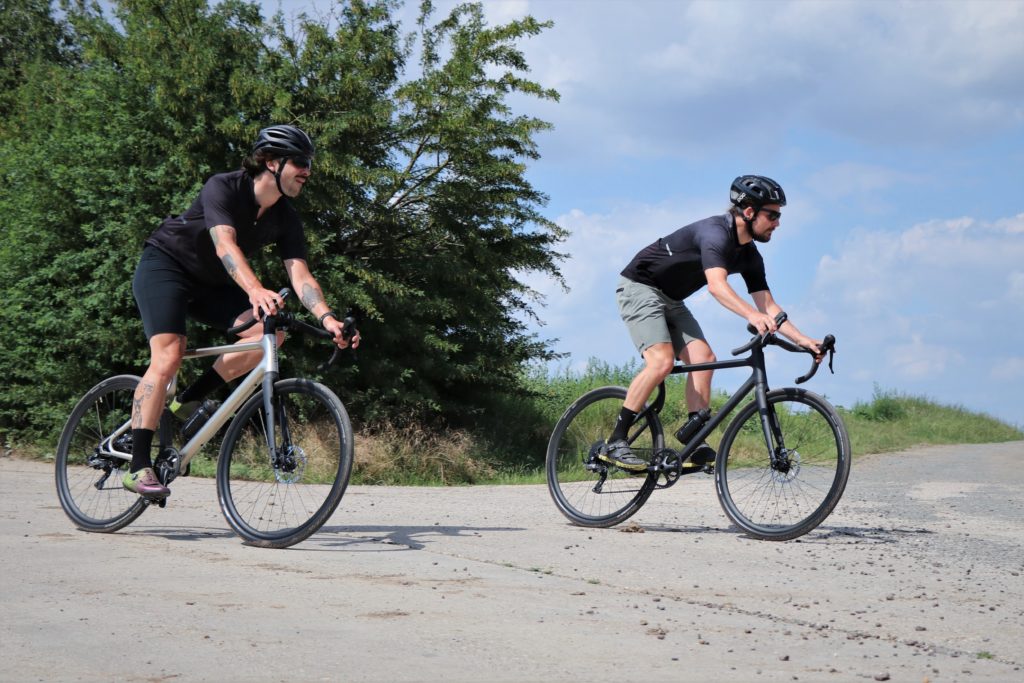German firm Urwahn has previously released the 3D printed urban Stadtfuchs bike and the Platzhirsch gates drive (e)bike. On the Standtfuchs, the firm used CL 50WS Maraging steel components made with GE Concept Laser machines. The Urwahn team use 3D printed brackets combined with tubing to make unique geometries and lightweight their bikes.

Now they’ve used this concept again to take the Waldwiesel and Waldwiesel.E gravel bikes into serial production. Both bikes can be customized to your liking, are offered in 250 frame colors, and have starting costs of $5,000 and $6,000, respectively. The electric drive is from Mahle and has 250 Wh that can take you up to 80 km in distance. The bikes also feature Shimano GRX 600 and Acros components (handlebars, bearings) with Shimano GRX 1-11 shifters.
Designed by Sebastian Meinecke, the frame is ingenious and sports what the company calls its Softride geometry, which lacks a seat tube. This is supposed to insulate the rider from unevenness and terrain. The company also operates under a Fair Frame concept that sees them using only local suppliers.

The company uses 1.2709 tool steel, which it says is made in Germany. This indicates that it’s probably made by Heraeus. This steel is used to print connective components welded to the tubing which consists of conventional CroMo tubes.
We reached out to Urwahn’s Silke Walter to find out more. One of the reasons why they’ve chosen steel is that, “Compared to carbon and aluminum, steel is much easier to process, repair and recycle. Accompanied by short production and logistics routes, we can also drastically reduce CO2 emissions for the benefit of our environment.”

The team is proud that they were also able to reduce the wall thickness of the 3D printed parts, as well as the overall wall thickness of the assembly of tubes and welds. They hope that further wall thickness reductions will make their bikes more efficient, For now, they’re pleased with how they’ve been able to get a universal thickness across the frame, which makes the bike look like its cast as a single item.
Walter went out of her way to point out that the team is not printing the entire frame, but rather those parts that matter and can give them the design and performance freedom that they need. When asked about the challenges of 3D printing the bike components she said,
“Ensuring a homogeneous surface finish is a challenge we had to meet. Furthermore, it is difficult to produce the lowest possible component weight, including material usage, while at the same time maintaining high stability. The process speed also poses a challenge to the cost-efficient nesting of the components.”
Finishing of metal printed parts has always been a multistep series of processes. Finicky and complex steps such as shot peening, de-stressing, tumbling and CNC take a lot of time and handling. High stability—or, in their case, low vibration and torsion—while maintaining thin walls and low mass is right on the edge of what a lot of people want to accomplish now. Vibration propagates while strength and stiffness change with different configurations, geometries and wall thicknesses. No one wants to add unnecessary weight to a bike. Simultaneously, low mass means less time in the machine and more profit for the business. The resulting design challenge can be a bit of a difficult one to balance correctly. Factor in nesting and you have the fun metal 3D printing boondoggle that a lot of people are dealing with worldwide.
I’ve written a series of articles on 3D printing bicycles and I’m very optimistic about bikes as an application. Whether for light-weighting or unique designs, small companies can innovate with 3D printed components. Mass customization could bring a lot of benefits to the cycling market, as well in making unique saddles or frame geometry. With bike prices high and geometry really making a lot of difference, Urwahn will not be the only ones 3D printing bike components.
Subscribe to Our Email Newsletter
Stay up-to-date on all the latest news from the 3D printing industry and receive information and offers from third party vendors.
You May Also Like
3D Printing Unpeeled: Wind Turbines, Probiotics and Lenses
TPI Composites, ORNL and Ingersoll Rand are working to make wind turbine tooling segments that can be 18.3 meters long. These elements also include resistive wires that help keep the...
3D Printing Unpeeled: Digital FDM Filament for Functional Gradients
Just published in Nature, a paper by a Seoul National University team looks at “3D printing with a 3D printed digital material filament for programming functional gradients.” Sang-Joon Ahn, Howon...
3D Printing Unpeeled: $5000 Cold Spray 3D Printer, Roland DGA & Living Materials
The AeroForge is a $5000 cold spray metal printer for copper made by a student team at Rice University. In a paper for ACS Central Science a team from Nanjing...
3D Printing Webinar and Event Roundup: April 28, 2024
In this week’s 3D Printing Webinar and Event Roundup, the Ceramics Expo is taking place in Michigan, Stratasys continues its advanced training courses, and SPE is holding a Polymer Characterization...































